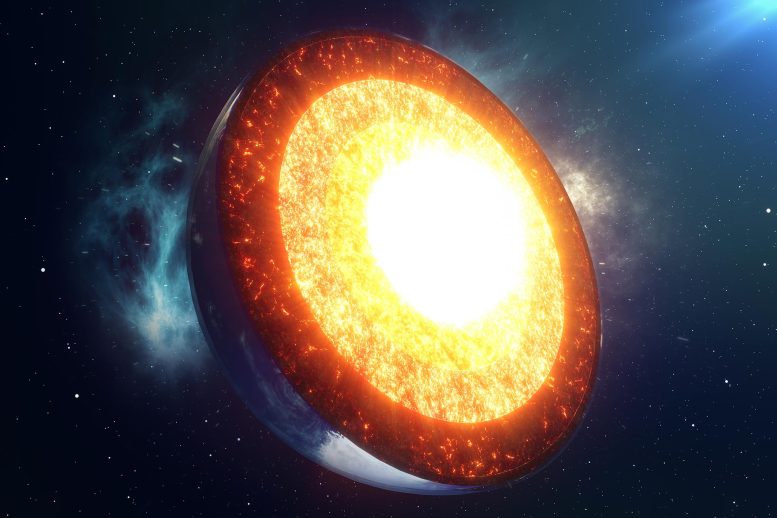
The slice you see cut out of the Earth reveals its core, depicted here in bright yellow. Our Earth, structured in layers similar to an onion, consists of a crust, mantle, outer core, and inner core, each with its own specific characteristics.
How has the inside of the Earth stayed as hot as the Sun’s surface for billions of years?
The Earth’s layered structure, which includes moving plates, is heated by remnants of the planet’s formation and the decay of radioactive isotopes. Geoscientists use seismic waves to study these internal structures and movements, which are critical for environmental changes and life evolution on Earth. The internal heat drives plate movements, contributing to phenomena like earthquakes, volcanic eruptions, and the creation of new land and oceans, thus making Earth habitable.
Our Earth is structured sort of like an onion – it’s one layer after another.
Starting from the top down, there’s the crust, which includes the surface you walk on; then farther down, the mantle, mostly solid rock; then even deeper, the outer core, made of liquid iron; and finally, the inner core, made of solid iron, and with a radius that’s 70% the size of the Moon’s. The deeper you dive, the hotter it gets – parts of the core are as hot as the surface of the Sun.
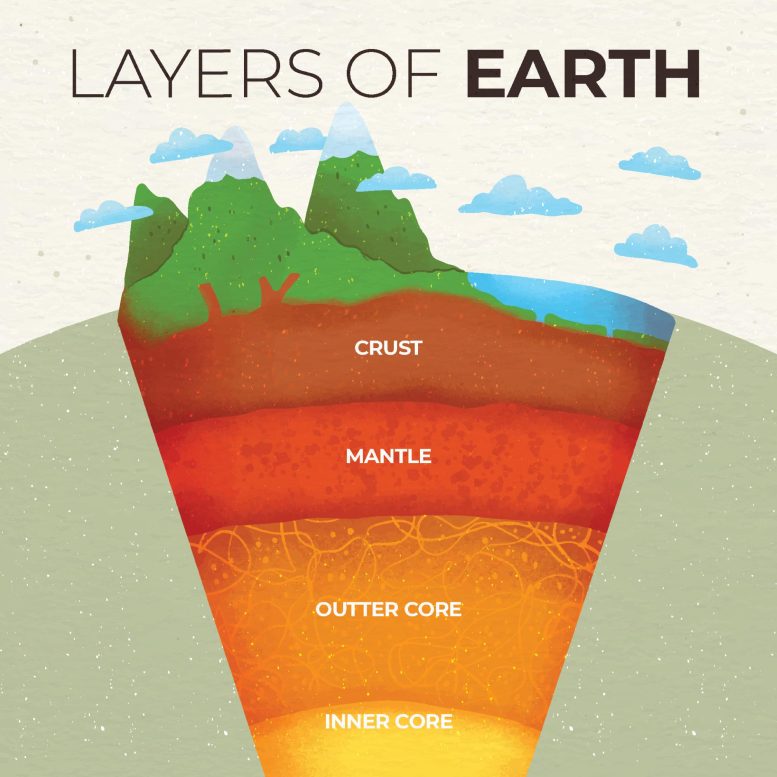
This illustration depicts the four sections beneath the Earth’s surface.
Journey to the center of the Earth
As a professor of earth and planetary sciences, I study the insides of our world. Just as a doctor can use a technique called sonography to make pictures of the structures inside your body with ultrasound waves, scientists use a similar technique to image the Earth’s internal structures. But instead of ultrasound, geoscientists use seismic waves – sound waves produced by earthquakes.
At the Earth’s surface, you see dirt, sand, grass, and pavement, of course. Seismic vibrations reveal what’s below that: rocks, large and small. This is all part of the crust, which may go down as far as 20 miles (30 kilometers); it floats on top of the layer called the mantle.
The upper part of the mantle typically moves together with the crust. Together, they are called the lithosphere, which is about 60 miles (100 kilometers) thick on average, although it can be thicker at some locations.
The lithosphere is divided into several large blocks called plates. For example, the Pacific plate is beneath the whole Pacific Ocean, and the North American plate covers most of North America. Plates are kind of like puzzle pieces that fit roughly together and cover the surface of the Earth.
The plates are not static; instead, they move. Sometimes it’s the tiniest fraction of inches over a period of years. Other times, there’s more movement, and it’s more sudden. This sort of movement is what triggers earthquakes and volcanic eruptions.
What’s more, plate movement is a critical, and probably essential, factor driving the evolution of life on Earth, because the moving plates change the environment and force life to adapt to new conditions.
You’ll be amazed at all the life happening below your feet.
The heat is on
Plate motion requires a hot mantle. And indeed, as you go deeper into the Earth, the temperature increases.
At the bottom of the plates, around 60 miles (100 kilometers) deep, the temperature is about 2,400 degrees Fahrenheit (1,300 degrees Celsius).
By the time you get to the boundary between the mantle and the outer core, which is 1,800 miles (2,900 kilometers) down, the temperature is nearly 5,000 °F (2,700 °C).
Then, at the boundary between outer and inner cores, the temperature doubles, to nearly 10,800 °F (over 6,000 °C). That’s the part that’s as hot as the surface of the Sun. At that temperature, virtually everything – metals, diamonds, human beings – vaporizes into gas. But because the core is at such high pressure deep within the planet, the iron it’s made up of remains liquid or solid.
Without plate tectonics, human beings probably would not exist.
Collisions in outer space
Where does all that heat come from?
It is not from the Sun. While it warms us and all the plants and animals on Earth’s surface, sunlight can’t penetrate through miles of the planet’s interior.
Instead, there are two sources. One is the heat that Earth inherited during its formation 4.5 billion years ago. The Earth was made from the solar nebula, a gigantic gaseous cloud, amid endless collisions and mergings between bits of rock and debris called planetesimals. This process took tens of millions of years.
An enormous amount of heat was produced during those collisions, enough to melt the whole Earth. Although some of that heat was lost in space, the rest of it was locked away inside the Earth, where much of it remains even today.
The other heat source: the decay of radioactive isotopes, distributed everywhere in the Earth.
To understand this, first imagine an element as a family with isotopes as its members. Every atom of a given element has the same number of protons, but different isotope cousins have varying numbers of neutrons.
Radioactive isotopes are not stable. They release a steady stream of energy that converts to heat. Potassium-40, thorium-232, uranium-235, and uranium-238 are four of the radioactive isotopes keeping Earth’s interior hot.
Some of those names may sound familiar to you. Uranium-235, for example, is used as a fuel in nuclear power plants. Earth is in no danger of running out of these sources of heat: Although most of the original uranium-235 and potassium-40 are gone, there’s enough thorium-232 and uranium-238 to last for billions more years.
Along with the hot core and mantle, these energy-releasing isotopes provide the heat to drive the motion of the plates.
No heat, no plate movement, no life
Even now, the moving plates keep changing the surface of the Earth, constantly making new lands and new oceans over millions and billions of years. The plates also affect the atmosphere over similarly lengthy time scales.
But without the Earth’s internal heat, the plates would not have been moving. The Earth would have cooled down. Our world would likely have been uninhabitable. You wouldn’t be here.
Think about that, the next time you feel the Earth under your feet.
Written by Shichun Huang, Associate Professor of Earth and Planetary Sciences, University of Tennessee.
Adapted from an article originally published in The Conversation.![]()

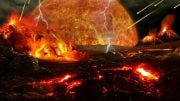



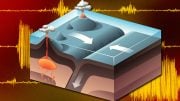
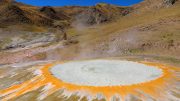


So the book/movie ‘Journey to the Center of the Earth’ probably wasn’t accurate?
That’s the theory. But let’s not confuse guesswork with what’s true.
So, the Earth has a 6000° core, keeping the planet warm for millions of years, but now we have eco-loons such as John Kerry, Joe Biden and Greta Thunberg, who want to spray sulphur in the sky to cool us down. I hope that people will finally see how insane an idea this is, the fact that they are even considering this should make everyone extremely angry and I hope that there is a way to stop these arrogant fools, who are hellbent on their enviro-loon quest to control everyone’s lives, anyone can obviously see that they are a far greater threat to humanity than some paltry variance in Earth’s surface temperature ever could be.
How could the planet slowly become layered while retaining an inner core with such heat ?! Obviously impossible. When facing an impossible occurrence, science conveniently gives it “millions and billions” of years to happen.
This is all BS, more made up science. Theory, guess work and therefore BS. Proving this is like disproving the hollow earth theory. Most everything we were taught and told throughout life is a lie/obfuscation.
The estimates of the temperature of the Earth’s center have changed every few years. Don’t take guesses as fact.
“and with a radius that’s 70% the size of the Moon’s.” A rather bizarre way to describe one of the Earth’s core layers. Further, this is an incomplete sentence. Any editing or proof reading going on at ScienceDaily?
With all the planets we’ve detected in other systems, were any of them molten balls? Very few, if any.
We need to revisit our old theories.
Very good science-based, current data on the subject of geosciences. Don’t listen to any of the looney tunes who make comments on this web page. I find it hard to believe that Americans, or perhaps others, would make these foolish comments that are so non-sensical and obviously immature. It’s truely disturbing and disheartening to see how mankind has been so dumbed down since I was in school in the 1950’s era. Knowledge through scientific discovery has moved at breakneck speed over the last 30 years. You would think that some of the fools who make such rediculous comments on this web page have likely been smoking their dope and don’t even have half a brain. Good job to the authors or curators who presented this web page and all its in-depth content. Many thanks for trying your best to educate the world masses, some who don’t even deserved to be enlightened. Keep up the good work